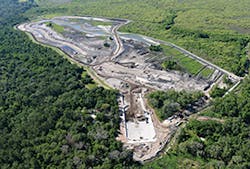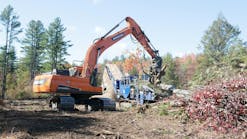Work on construction sites may increase the rate of erosion by as much as 1,000 times the preconstruction rate, according to EPA. The main problem associated with erosion at these sites is the impact of sediment on water quality. It may contain lead, arsenic, and mercury; oils, petroleum, and VOCs (volatile organic compounds); nitrates and phosphates; and herbicides and pesticides.
A construction site’s stormwater pollution prevention plans (SWPPPs) should minimize the amount of disturbed soil, prevent runoff from flowing across disturbed areas, slow runoff, and remove sediment before it leaves the site. SWPPPs should meet or exceed local or state requirements for sediment and erosion control plans, also according to EPA.
The selection of soil erosion and sediment controls should be based primarily on the nature of the construction activity and the conditions at the site. Techniques for erosion control focus on preventing soil from moving. They include clearing and grading the site as needed, planting temporary vegetation, and constructing detention ponds and check dams.
Products for sediment control generally capture the sediment once the soil has been displaced. Most of these are barriers that slow the flow of water, allowing sediment to drop out and the filtered water to pass through. Each product has its own advantages.
Silt fences intercept sheet flow runoff at the perimeter of construction sites or a project within a site. There are traditional silt fences, silt fences with extra flexibility, and silt fences reinforced with a liner or by a wire mesh or chain link fence for extra strength. They are made of one or more geotextile materials, and may be dug in by hand or bladed in, with stakes of wood or metal that may come separately or built in.
For sites with heavier water flow, wattles-also called tubes, logs, and rolls-may be filled with mulch or compost, straw, flax, rice, foam, or shredded tire rubber, and may let water through or hold it back. They may be encased in netting or fabric that is biodegradable or nonbiodegradable.
Wattles in their simplest form are berms, which contractors may build onsite.
Bags filled with sand, gravel, or other materials may be placed in a series to interrupt sheet flows and allow sediment to settle out. They can be used around site perimeters, inlets, and temporary stockpiles of dirt. They may be filled by hand, by the manufacturer, or by a specialized attachment that fits on other pieces of equipment at the site.
Loose straw may be used to cover disturbed ground, either spread by hand or blown across the site by a machine or equipment attached to a machine.
Any exit from the site can be an especially challenging area to protect from sediment loss, because vehicle traffic leaving the site may track out mud and dirt on tires. BMPs here consist of sheets of metal or geotextile with ridges to shake dirt from the tires.
Inlet protection slows runoff and allows sediment to fall out before it reaches storm drains. Storm drain protection catches the remaining sediment before it reaches the storm pipes. These barriers may be of a geofabric or they may be coir fiber mats bonded to a fiberglass mesh backing.
Most of these products are designed to be removed at the end of a project. Many can be reused. Some, especially the ones made of organic matter, can be slit open and, if desired, seeded.
Construction sites often use a treatment train, a combination of techniques, to increase the effectiveness of the controls and provide continued protection in case one fails. This is the case in the first two projects below: the Burke Lakefront Airport Project in Indiana and the Payne’s Prairie Preserve State Park Sheetflow Restoration Project in Florida. The third project shows the effectiveness of exit protection.
The Burke Lakefront Airport Project
Burke Lakefront Airport, on the shore of Lake Erie and at the edge of downtown Cleveland, OH, handles more than 90,000 flight operations per year. Opened in 1948, the 450-acre general aviation reliever airport for Cleveland Hopkins International Airport is undergoing major exterior renovations.
Chief among them is the upgrade of its two runways to bring them into compliance with new runway safety standards mandated by Congress. These standards state that runways must have a 600-foot runoff to give aircraft that overshoot the runway sufficient space to stop.
During construction, the main sediment control BMPs are compost-filled tubes, or wattles, from Filtrexx International LLC in Grafton, OH. The company’s Sediment Control Filtersoxx are being used for perimeter control and its Inlet Protection wattles for curb inlet protection. The Soxx can be customized for use on and around construction sites and any other environmental, agricultural, landscape, or garden application.
They were chosen primarily because they let runoff through slowly, says Rick Robertson, project manager for Independence Excavating in Cleveland, which is working on the site. The runoff leaves sediment behind, and there’s only temporary ponding.
“You don’t want ponding. It’s hard to do earthwork when water ponds, and standing water at airports attracts birds. We’ve used the Soxx before. I think they’re a great product. They’re easy to install and long lasting.”
The airport has two east-west runways, one 6,198 feet by 150 feet and the other 5,200 feet by 100 feet. They’re separated by a distance of 510 feet and connected by four taxiways. One will be shifted 600 feet to the east, which will give it the required length. The second runway lacks the free space.
Instead, says Robertson, “The airport will install an EMAS [engineered material arresting system] of crushable cellular cement blocks at end of the runway to stop or slow an aircraft that overshoots it before it goes into the lake.”
The system consists of a 400-foot bed of the blocks. The weight of an aircraft traveling on them will crush the blocks, causing it to lose energy. The concept is the same as a runaway truck ramp made of gravel or sand.
The Federal Aviation Administration (FAA) and the Cleveland Airport System will share the $20 million cost to upgrade the runways as well as to build two new taxiways.
Independence Excavating has been serving the industrial, commercial, and heavy highway industries in the Ohio-Pennsylvania-Washington DC area for 53 years. The company began work on this site in June 2012.
“This job is approximately 100 acres,” Robertson says. “Before we disturbed the ground, we did the sediment control.”
The Soxx arrived on 100-foot-long pallets. Independence Excavating installed 11,218 feet of them with a skid steer, overlapping the ends by about 4 feet and pounding in wooden stakes every 10 feet on center to keep them in place. They also placed the Filtrexx Inlet Protection wattles around all the inlets.
The mesh around the Soxx comes in photodegradable polyethylene and biodegradable cotton. The media consists of natural, organic, slow-release nutrients, minerals, and beneficial bacteria and fungi.
If a section of the Soxx is damaged, the damaged part can be cut out, the ends bound up, and a new section laid down overlapping the ends of the existing ones.
The company is using additional sediment control measures. Although crews have to grade large areas at a time, they’re leaving grassy areas between the sections they’re working on whenever possible. They also dug some sediment traps and detention ponds onsite.
They began by removing pavement where it was required, and are excavating between 5 and 10 feet deep. The depth depends on the locations of the utilities that the FAA is installing underground.
The 16-day shutdown of the federal government in October 2013 shut down the company’s work, too. “There’s a domino effect,” Robertson says. “If they can’t put the conduit or wires in, we can’t fill over them.”
Rain also has caused some delays, he says. “It rained a lot while we were working, and we had to wait until the dirt dried out. We can’t grade it when it’s wet, and we have very specific compaction requirements for runways. It has to be 100%.”
Independence Excavating is cutting and filling the unpaved areas to planned grade. Crews are seeding and mulching to establish permanent vegetation.
They are laying 2 feet of stone under the taxiways and runways and compacting it, to 100% for the runways. They then pave over both.
Once the site is stabilized, they cut open the sox and spread the mulch.
“Working at airports is always challenging,” Robertson says. “There’s the security. The airport and the runways are still open, and we have to be conscious of dust that might get in the way of the planes.”
According to the FAA, because debris-including sediment-creates safety hazards at airports, it has engaged in a reporting program for foreign object debris (FOD). The goal of the program is to provide an awareness of FOD events, identify reoccurring FOD issues, and isolate problem areas in American airports.
Evolving EPA regulations haven’t been affecting the way Independence Excavating works, Robertson says. “We have to follow our stormwater protection plan, but EPA regulations haven’t changed much in the past five years.”
Construction-site inspections are conducted weekly and after rain events that produce more than half an inch of rain in 24 hours.
Payne’s Prairie Preserve
Before cattle ranchers dug a drainage ditch to expand their grazing areas in Payne’s Prairie in Florida in the 1930s, sheetflow of water from Sweetwater Branch creek would spread across the 2,500-acre wetlands. The wetlands provided a natural filter for the water, which would infiltrate into the Floridan Aquifer.
Now, nutrients in the creek, especially nitrogen and phosphorous, are impairing the aquifer and the wetlands, which in 1971 became the state’s first wildlife preserve.
Water runs from Sweetwater Branch through Gainesville to the 2-mile ditch, and from there directly into Alachua Sink, a small sinkhole lake in the wetlands that connects to the aquifer. Along the way, it picks up excess nutrients from urban stormwater runoff, wastewater, septic systems, and discharge from the city’s water reclamation facility. Although the discharge is highly treated, it doesn’t meet current water-quality standards.
EPA recently developed total maximum daily load (TMDL) requirements for nitrogen in Alachua Sink that require reductions in the total nitrogen load.
“Gainesville Regional Utilities [GRU] had several options,” says Robyn Dowsey, department manager for the sustainable design and construction department with Wharton-Smith, a general contractor, construction manager, and design-build contractor headquartered in central Florida. Wharton-Smith has been ranked consistently by Engineering News Record as a Top 400 Contractor and Top 200 Environmental Contractor.
“GRU chose to be more in line with LID (low-impact development) and create a natural wetlands that would reduce the nitrogen levels and restore the hydrology of Payne’s Prairie,” Dowsey says. The project also will help with stormwater management, improve water quality in the lake and the aquifer, create a high-quality wetland habitat, and increase the acreage of conservation lands within the park.
GRU is making improvements to its water reclamation facility as well as constructing 19,000 linear feet of gravel or asphalt roadways, gravity sewer mains and force mains (pipelines that convey wastewater to a discharge point under pressure), and electrical infrastructure.
Partners in the project include the City of Gainesville Public Works Department, the Florida Department of Environmental Protection, the St. Johns River Water Management District, the Florida Department of Transportation, and Alachua County. It will cost some $5.7 million and is expected to be finished in mid-2014.
Sediment control in wetlands is challenging, Dowsey says. First, they contain large amounts of water and organic soils, which have small particulates. She chose the heavy-duty Belted Silt Retention Fence (BSRF) Priority 1 green band from Silt-Saver Inc. in Conyers, GA.
“We’re using the highest standard of silt fence,” she says. “BSRF has a great filter capability. Regular silt fence doesn’t work well with small particles. It made sense to us.”
The 256-acre project began in 2012 and involves in excess of one million cubic yards of earthwork. Wharton-Smith will fill in the drainage ditch to restore the natural sheetflow of water across the wetlands. It also will excavate, reshape, restore, and stabilize the site, building 40- to 50-acre wetland cells planted with specific vegetation to remove nitrogen from the water as it filters through the soil.
The company began with limited site clearing to put in the initial BMPs.
Working in a wetlands environment presents many difficulties: It rains frequently, the soils are wet, and the wildlife includes bobcats, bison, and wild horses, as well as alligators and water moccasins. “We wear very high snake-proof rubber boots,” she notes.
Another challenge on this project is the turbidity requirement. On most construction sites the requirement is 29 nephelometric turbidity units (NTUs), but on construction sites in state parks the requirement is 0 NTU. “It doesn’t have to be 0 NTUs all the time, but if it gets above that, we have to be able to make adjustments on the fly to achieve 0 NTUs,” Dowsey says.
Wharton-Smith’s work hasn’t been affected by evolving EPA regulations, largely because it consistently goes beyond minimum standards, beginning with sediment control. The company has an elaborate treatment train and is meticulous about maintaining it.
“We have a lot of different BMPs, so if one system doesn’t work, a chain of them protects the overall job,” she says.
The BSRF is a 36-inch-wide, nonwoven spun-bond polyester fabric with an internal scrim-a heavy, coarse woven fabric for reinforcement. It comes sandwiched with the wood posts already attached, so installation is simple, she says. Wharton-Smith bladed in the fence.
With a lifespan of one year, BSRF is very sturdy. It’s been overtopped with water on this project and has held fast. Still, she says, it can be damaged by animals and equipment.
“As with any silt fence product, maintenance is the key. It has to be constantly reviewed and repaired as necessary.” It’s easy to replace small sections by hand, and when the job is done, to remove it by machine.
In addition to the BSRF, they’re using regular silt fence, turbidity barriers, jute netting, and polyacrylamides to aggregate the particulates. They expose only a certain area at one time, berm their working area, use temporary seeding, and build check dams.
“In some places, we’re using a double layer of silt fence with polyacrylamides and berms in between,” she says. “We also use mulch and tree branches, and layer the powder in the material. We’re creating a treatment sandwich.”
A constructed enhanced wetlands is essentially a low-flow water system planted with specific vegetation, she says. It looks natural and uses natural processes to filter the water.
The difference, according to EPA, is that there are water-control structures to establish desired hydraulic flow patterns. They include berms to enclose the cells as well as inlet and outlet structures. The shape, size, and complexity of the design are often a function of the site characteristics.
When water enters a wetlands cell, suspended waste materials are strained out and trapped by plants and plant litter. They are consumed by bacteria and converted into other substances, and the filtered water infiltrates into the aquifer.
When the entire project is finished, it will include an entry parking area, a welcome classroom, a security residence, restrooms, boardwalks, and viewing overlooks.
Construction Site Exits
Because trucks and equipment leave construction sites with particles clinging to their tires, the exits pose a unique challenge.
BMP Solutions installs and maintains BMPs on sites in northern and southern California. Most of the company’s work on construction sites is on new residential and commercial projects between 1 and 10 acres in size, says Tony Decker Jr., the project manager and estimator.
The company uses Rumble Tracks, by Contractors-Services LLC in Lakewood, CA, at the exits to help keep sediment and mud onsite. Crews also use silt fence, straw wattles, and sandbags for perimeter protection.
“We install per the plan,” Decker says. The bigger the site, the more material used and the larger variety of materials.
The tracks are very effective, he adds. They solve the PM10 dust abatement problem because dust doesn’t become airborne in the first place. They work well in the rain when vehicle tires are creating mud. And according to the manufacturer, they reduce the need for water trucks and sweeping time significantly.
“We have Rumble Tracks on about 40 projects that we’re working on now. At Camp Pendleton there are about 30 plates at 10 different exits on six separate sites. At the University of California Riverside, they’re building a new student center and they’re using six trackout plates,” Decker says.
Rumble Tracks are flat metal plates, typically 8 feet by 10 feet, with metal ridges. They work by shaking out dirt, mud, and other debris from tires as vehicles drive on them. BMP Solutions advises users to sweep the sediment off the tracks once a week, or, if clients wish, the company will do it for them.
To install the tracks, BMP Solutions excavates the existing soil at the exit approximately 50 feet by 20 feet by 6 inches. Crews lay a filter fabric of black felt on top and spread a 6-inch layer of 3-inch construction rock on the fabric, then compact the rock. During the process they must be careful not to crack or break any existing-and unmarked-pipe underground.
Rumble Tracks are very easy to lay down and to remove. A crane lifts them from a truck and places them on the rock bed in the desired configuration, from a single track to three lined up in a row or four in a rectangle. When the job is done, a crane lifts them up and puts them back on a truck, which takes them to the next job.
“Every once in awhile one will bend a little because of the weight of a giant piece of tracked equipment, but for the most part they’re on job sites for two or three years and they’re perfect,” Decker says.
New environmental regulations are helping the company’s business, he notes. Municipalities and agencies are taking sediment control more seriously now, and inspectors often are at construction sites once a week.
BMP Solutions does the maintenance on sites once a week or once a month, depending on the contractor. In addition to sweeping the tracks, workers reinstall any material that has fallen or been damaged, replace gravel bags, sweep job sites, and clean up mud and silt.
“Rumble Tracks work great,” Decker says. “We’ve been on job sites that use rock instead. We’ll get a call once the job starts, because rock doesn’t do as good a job. If you go the cheap way, it often isn’t the right way.”



